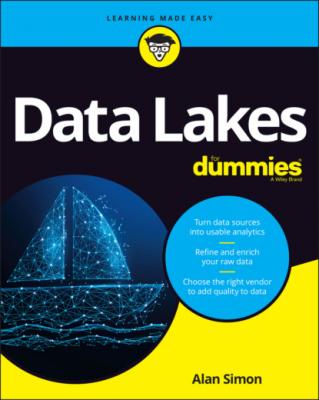Data Lakes For Dummies. Alan R. Simon
Читать онлайн.| Название | Data Lakes For Dummies |
|---|---|
| Автор произведения | Alan R. Simon |
| Жанр | Базы данных |
| Серия | |
| Издательство | Базы данных |
| Год выпуска | 0 |
| isbn | 9781119786184 |
To support this near-constant expansion and growth, you need to ensure that your data lake is well architected and solidly engineered, which means that the data lake
Enforces standards and best practices for data ingestion, data storage, data transmission, and interchange among its components and data delivery to end users
Minimizes workarounds and temporary interfaces that have a tendency to stick around longer than planned and weaken your overall environment
Continues to meet your predetermined metrics and thresholds for overall technical performance, such as data loading and interchange, as well as user response time
Think about a resort that builds docks, a couple of lakeside restaurants, and other structures at various locations alongside a large lake. You wouldn’t just hand out lumber, hammers, and nails to a bunch of visitors and tell them to start building without detailed blueprints and engineering diagrams. The same is true with a data lake. From the first piece of data that arrives, you need as solid a foundation as possible to help keep your data lake viable for a long time.
A really great lake
You’ll come across definitions and descriptions that tell you a data lake is a centralized store of data, but that definition is only partially correct.
A data lake is logically centralized. You can certainly think of a data lake as a single place for your data, instead of having your data scattered among different databases. But in reality, even though your data lake is logically centralized, its data is physically decentralized and distributed among many different underlying servers.
FIGURE 1-1: A logically centralized data lake with underlying physical decentralization.
Expanding the data lake
How big can your data lake get? To quote the old saying (and to answer a question with a question), how many angels can dance on the head of a pin?
Scalability is best thought of as “the ability to expand capacity, workload, and missions without having to go back to the drawing board and start all over.” Your data lake will almost always be a cloud-based solution (see Figure 1-2). Cloud-based platforms give you, in theory, infinite scalability for your data lake. New servers and storage devices (discs, solid state devices, and so on) can be incorporated into your data lake on demand, and the software services manage and control these new resources along with those that you’re already using. Your data lake contents can then expand from hundreds of terabytes to petabytes, and then to exabytes, and then zettabytes, and even into the ginormousbyte range. (Just kidding about that last one.)
FIGURE 1-2: Cloud-based data lake solutions.
Some of the very first data lakes that were built in the Hadoop environment may reside in your corporate data center and be categorized as on-prem (short for on-premises, meaning “on your premises”) solutions. But most of today’s data lakes are built in the Amazon Web Services (AWS) or Microsoft Azure cloud environments. Given the ever-increasing popularity of cloud computing, it’s highly unlikely that this trend of cloud-based data lakes will reverse for a long time, if ever.
As long as Amazon, Microsoft, and other cloud platform providers can keep expanding their existing data centers and building new ones, as well as enhancing the capabilities of their data management services, then your data lake should be able to avoid scalability issues.
More than just the water
Think of a data lake as being closer to a lake resort rather than just the lake — the body of water — in its natural state. If you were a real estate developer, you might buy the property that includes the lake itself, along with plenty of acreage surrounding the lake. You’d then develop the overall property by building cabins, restaurants, boat docks, and other facilities. The lake might be the centerpiece of the overall resort, but its value is dramatically enhanced by all the additional assets that you’ve built surrounding the lake.
In addition to data storage, a data lake also includes the following:
One or (usually) more mechanisms to move data from one part of the data lake to another.
A catalog or directory that helps keep track of what data is where, as well as the associated rules that apply to different groups of data; this is known as metadata.
Capabilities that help unify meanings and business rules for key data subjects that may come into the data lake from different applications and systems; this is known as master data management.
Monitoring services to track data quality and accuracy, response time when users access data, billing services to charge different organizations for their usage of the data lake, and plenty more.
Different types of data
If your data lake had a motto, it might be “All data are created equal.”
In a data lake, data is data is data. In other words, you don’t need to make special accommodations for more complex types of data than you would for simpler forms of data.
Your data lake will contain structured data, unstructured data, and semi-structured data (see Figure 1-3). The following sections cover these types of data in more detail.
Structured data: Staying in your own lane
You’re probably most familiar with structured data, which is made up of numbers, shorter-length character strings, and dates. Traditionally, most
